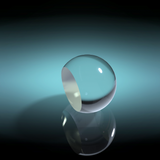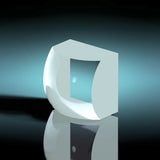-
Ball lenses in their complete form have a long tradition of manufacturing and use. They are also a good starting point for making other lens types that would otherwise be tricky to make. For example, flattening and polishing one side of the sphere result in the general plano-convex, half ball, or aplanatic lens depending on its central thickness. For the half ball lens, that thickness is D/2 and D/2+D/2n for the aplanatic lens. By further simple transformations of these lenses, it is possible to get the drum or the rectangular shape of these lenses.
The Effective focal length (EFL) and Working distance (WD) of cut-ball microlenses at the selected wavelength depend on the glass refractive index n, the parent ball diameter D, and its central thickness t:

-
Radius of Curvature Tolerance +/- 0.005 mm
Drum Diameter Tolerance +0.00 / -0.02 mm Square Dimension Tolerance +0.00 / -0.02 mm Central Thickness Tolerance +/- 0.01 mm Centering < 3arcmin AR Coating R < 0.5%, AOI 0-30°
- choosing a selection results in a full page refresh






